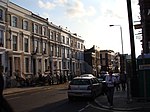St Charles Catholic Sixth Form College
St Charles Catholic Sixth Form College is a Roman Catholic sixth form college located in the Royal Borough of Kensington and Chelsea, in Central London, England. It was originally Cardinal Manning Boys School, founded in 1955 and became St Charles Catholic Sixth Form College in 1990 following a reorganisation of the Catholic education system within the Archdiocese. It is part of a cluster of Catholic institutions located at St Charles Square which includes Sion Manning Roman Catholic Girls' School, St Charles Primary School, a church and a Carmelite convent. The college offers a range of courses for students graduating from local schools in the surrounding area. These courses include GCSEs, A Levels and BTECs.
Excerpt from the Wikipedia article St Charles Catholic Sixth Form College (License: CC BY-SA 3.0, Authors).St Charles Catholic Sixth Form College
St Charles Square, London North Kensington (Royal Borough of Kensington and Chelsea)
Geographical coordinates (GPS) Address Phone number Website Nearby Places Show on map
Geographical coordinates (GPS)
| Latitude | Longitude |
|---|---|
| N 51.52133 ° | E -0.21514 ° |
Address
St Charles Catholic Primary School
St Charles Square
W10 6EB London, North Kensington (Royal Borough of Kensington and Chelsea)
England, United Kingdom
Open on Google Maps






